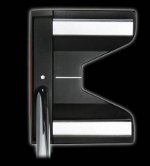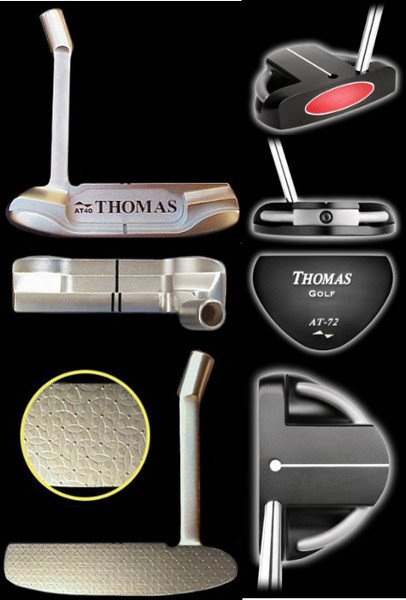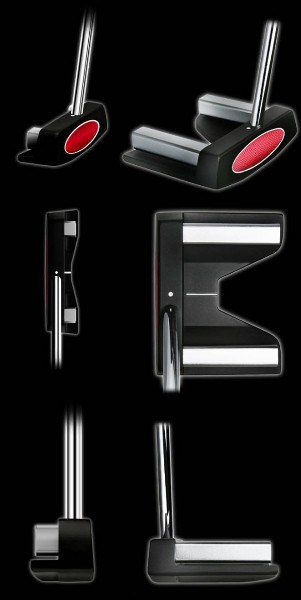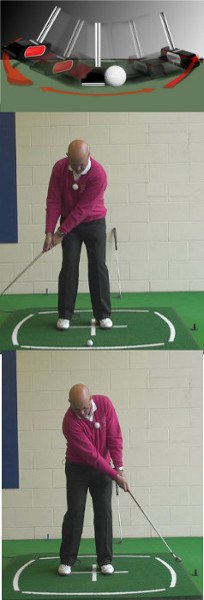The putter is perhaps the most personal club in a golfer's bag. How a putter looks and feels is every bit as important as its technology. Some players prefer a blade style putter while others are more comfortable with a mallet.
Let's examine each type.
Basically, a blade putter is longer from heel to toe than from face to back. While the blades of yesteryear featured simple designs (think of the classic Bullseye putter), most of today's models incorporate perimeter weighting into a cavity-back construction.
There's huge variation within the blade style, too. Some have a “plumber's neck” hosel with marked offset, while others are shafted straight into the head. There are even a few that resemble the designs of old.
 The body of a mallet putter is deeper from front to back, which places the center of gravity farther away from the face and creates a higher moment of inertia (MOI). That means better stability on off-center hits, so poor putts don't stray as far off line. Mallet putters often have built-in alignment aids and can feel slightly heavier than blades.
The body of a mallet putter is deeper from front to back, which places the center of gravity farther away from the face and creates a higher moment of inertia (MOI). That means better stability on off-center hits, so poor putts don't stray as far off line. Mallet putters often have built-in alignment aids and can feel slightly heavier than blades.
It's wise to try several varieties of both styles to find one that fits your eye and stroke.
Thomas Golf Putters
Traditional, Mid-Length/Belly & Long Putters

Blade vs. Mallet Putter Heads
Picking out the right equipment for your game is one of the most important tasks that you have as a golfer. While good gear is never going to make you a great player automatically, it can help you to get the most from your skill set. When playing golf with clubs that are ill-fitted to your abilities, you will be fighting both the course and your equipment – and you are likely to lose those fights. Make sure you have the right clubs in your bag in order to give yourself the best possible chance at success on the scorecard.
The putter that you choose to put in your bag is near the top of the list when it comes to key equipment choices. Unlike the rest of your clubs, where you have to worry about things like shaft flex and other technical points, the putter really just comes down to personal preference. You aren't going to be swinging this club hard, so the shaft isn't a factor. In the end, you have to find a quality putter that feels good in your hands, looks good to your eye, and allows the ball to roll on line time after time.
This may sound like a relatively easy task, but many golfers go for years and years without settling on a putter that they truly trust. In order to make the process of picking out a putter just a bit easier, you should first decide whether you are looking for a blade or mallet putter head style. By choosing one style or the other right off the top, you can eliminate half of the market and narrow down your search. There are pros and cons to each type of putter, and you can find plenty of both represented in the bags of the best golfers in the world. As is the case with many things related to golf equipment, there is no 'right' or 'wrong' in the debate of blade vs. mallet. Instead, it boils down to which one works best for you.
Most likely, you already have some experience in rolling putts with both a mallet and a blade putter. Even if you have only owned one or the other, you have likely borrowed a putter from a friend or tried other models out in the store. However, even if you have used both styles of putter, you may not really understand how each of them works. In the content below, we will get into the details of how each style of putter works, and what kind of stroke is a good match for each. Hopefully, this information will help you to determine which kind of a putter you should be using. The advice below, along with some practice time with both types of putter heads, should lead you to a smart putter selection and plenty of made putts in the years to come.
All of the content below is based on a right handed golfer. If you happen to play left handed, please take a moment to reverse the directions as necessary.

The Basic Differences
It doesn't take an expert in golf equipment design to notice the basic differences between a mallet putter and a blade putter. The mallet head style often looks like a half-circle, with a large mass behind the putter face. Different mallet putters feature different designs on top of the mallet itself, but the concept is essentially the same from one model to the next. These putters are almost always heavier than blade putters, and they tend to offer a somewhat softer feel at impact as well.
Blade putters, obviously, are thin in design, although there are a variety of different design elements that can still be included while remaining in the blade category. The first putters were blade designs, so many golfers think of this as being the 'classic' type of putter. Lighter in weight than their mallet counterparts, most golfers report more feel from a blade putter – but the trade off is usually in the lack of forgiveness that is experienced. In many ways, comparing blade and mallet putters is like comparing blade and cavity back irons. The blades offer more feel and control in the hands, while the mallet or cavity back provides the player with added forgiveness and playability.
Already you can see a basic framework shaping up for how you are going to select your putter style. If you like a putter that gives you great feedback into your hands when you strike a putt, a blade design is almost certainly going to be the right choice. On the other hand, if you are simply looking for the most forgiving putter that you can find, a mallet should win the day. Mallet putters aren't going to turn bad strokes into good ones, but they can help keep the ball close to your target line even if you strike the putt slightly off center. Blade putters tend to punish off center hits more harshly, meaning you have to be dialed in if you want to hole out consistently.
It is important to point out that not all blade and mallet putters are created equal, so you will need to certainly test out any putter you are considering before purchasing it and placing it in your bag. Some mallet putters won't offer much in the way of forgiveness, while some blade models will actually feel quite forgiving. It is helpful to understand the basic general guidelines for how these types of putters perform, but you have to remember that each putter is its own piece of equipment and will have its own performance characteristics. Only when you test out a putter in your own hands can you really decide how it is going to work for you.
There is an element of visual appeal to this 'debate' that needs to be remember as well. The visual side of the equation has nothing to do with how the ball is going to come off the face of your putter, but it still matters in terms of your confidence level standing over the ball. You need to feel like you are going to make each putt before you start your stroke, and having a putter that looks good to your eye will go a long way toward building that necessary confidence level. If you hate how your putter looks, you are more likely to have a negative expectation for your putts. Decide for yourself whether you prefer the look of a mallet or blade putter and then take that preference into consideration before making your eventual choice.

Matching Your Putter to Your Stroke
If you already play the game of golf, you already have a putting stroke. You might not be particularly happy with your stroke, but it is the only one you have. While you can certainly work on some drills and new techniques to improve your stroke, you should also pick out a putter style that matches up nicely with how you swing the club through the ball. Some strokes are best suited for a blade design, while others will perform best when matched up with a mallet. The points in the list below will help you settle on the right style of putter head for your stroke.
- How much release is in your stroke? Some golfers like to release the putter aggressively through the ball, with the toe passing the heel right at the moment that the ball is struck. This is commonly referred to as an 'arc' putting stroke, as the putter swings to the inside on the backstroke and again on the forward stroke. If you like to swing your putter along an arc, you will likely be best served with a blade putter. Blade putters are usually designed with this kind of stroke in mind, where mallet putters are better for strokes that swing 'straight back and straight through'. If you try to keep your putter face square to the target line throughout your stroke, a mallet will probably make the best choice. Due to their weighting, mallet putters usually don't perform well when swung on an arc, but they are a natural fit it you want to hold the face square.
- What tempo do you use? Simply put, golfers who use a quick tempo in the putting stroke should usually pick a blade putter, while those with a slower rhythm will prefer a mallet. This point all comes down to weighting. Blade putters tend to be lighter than mallets, therefore they usually perform better when moved with a quick pace. You don't want your putter to be fighting against the tempo that you would like to use, so make sure that the speed of your stroke is going to be a good fit for the putter in your hands – and vice versa.
- Is there any hitting action at impact? When you make contact with the ball during your putting stroke, are you simply brushing through impact or are you giving the ball an active hit to send it toward the hole? Both methods can be useful, but they are quite different in the technique required to use them successfully. If you like to be able to hit the ball toward the hole, a blade putter is the easy choice. On the other hand, if you would rather brush the ball toward the hole with no active hit action, a mallet is going to give you the feel that you need. Think about the way your stroke works currently and decide on the right putter for you based partially on this point.
You probably don't need to set foot out on the practice putting green in order to decide which model is going to be right for you. Just by thinking about how you putt, you can probably make a wise determination on whether a mallet or blade is going to work best for you over the long run. Once you have thought about how your stroke works and which model you think will be best, head to your local golf shop to confirm your feelings. Try to roll some putts with both a blade putter and a mallet putter and see if your expectations have been confirmed. As long as you are finding the results that you expected, you can be confident that your choice will be the right one.

Golf Course Conditions Should Be Considered
The way you like to putt the golf ball should account for the majority of your decision making process in the debate between mallet and blade putters. However, there is also a little bit of room in this discussion for the conditions of the golf courses that you usually play. Specifically, you should think about the condition of the greens that you are typically putting on during an average round. Naturally, you want a putter that will not only perform well in your hands, but one that will also perform well on the kinds of greens that you usually face.
To add in golf course conditions to your decision making process, consider the points below –
- Speed of the greens. This is naturally the first course conditions point that you should think about when picking a putter. Do you play on fast greens, slow greens, or something in the middle? Players who play regularly on fast greens might enjoy the smooth rhythm that is developed by a mallet putter. While you can certainly use blade putters on fast greens – professional golfers do it all the time – there is slightly more skill required to control the roll of the ball. On the contrary, slow greens are much easier to handle with a blade putter, as you will need a little bit of hit in your stroke to reach the target. Trying to handle slow greens with a mallet is a tough task, so think twice before buying a mallet if you are playing most of your golf on greens with slow speeds.
- Type of grass. Some grasses, like Bermuda, have a strong grain to consider while putting, where others do not. If you are putting on grainy greens (often the case in warm climates), you may want to favor a blade over a mallet. Again, there is going to be a need to hit the ball aggressively in order to hold the line on grainy greens, and a blade putter is better suited for that job. When grain isn't much of a consideration, you can ignore this point completely and simply pick the putter that is best for you based on all of the other factors.
- Size of the greens. One point that many players overlook is the size of the greens at their favorite course (or courses). If you play on big greens, you are likely to have plenty of long putts during an average round – and mallet putters can give you trouble when putting from long range. Swinging the larger and heavier putter head through the ball at the right speed to reach the hole can be difficult when you are facing a long distance roll, so many players prefer a blade putter for the job. Obviously, if you play a golf course with small greens, dealing with long putts won't be much of a factor – so you can feel free to pick a mallet if it is the best tool for the job.
You should really only think about course conditions when picking a putter if you tend to play all of your golf on the same one or two courses near your home. If you are a player who likes to travel to experience different courses, there probably isn't any way to factor in this part of the equation, as you are going to see various conditions from course to course.
Should you happen to be someone who does have a home course which you play regularly, consider asking for a 'demo' putter to try out any putter that you are considering under real conditions before making the purchase. Your pro shop may allow you to take a club out onto the course for a round before buying it, giving you the chance to see how it really performs on your greens. After trying out a couple of putters under 'live' conditions, you should have a pretty good idea of which one is going to work best for you.

The Value of Loyalty
With all of this talk about picking out a new putter to add to your bag, it should be mentioned that there is something to be said for loyalty to your golf equipment – especially when it comes to the putter. Confidence is something that can be hard to find in golf, so you don't want to throw out a club that gives you confidence simply because you are looking for the next greatest thing in golf gear. If you are currently putting well, the best thing you can do is keep your current putter and enjoy the results you are seeing. Only when you really struggle should you turn to an equipment change as a way to get things back on track.
This point should highlight how important it is to take your time when picking out a putter. If you are going to buy a new putter in the near future, you should take your time to work through the process – including trying to decide whether you are going to buy a mallet or blade model. By taking this process seriously from the start, you will have a better chance of winding up with a club that you can be loyal to for many years to come. If you are willing and able to stick with this putter for the foreseeable future, you will develop a comfort level with it that is crucial to performing well on the greens.
Professional golfers are well-known for their propensity to switch to near gear in search of better results. Clubs often don't last long in the bags of the pros, as they are swapped out for newer models on a regular basis (partly for the benefit of the equipment companies, of course). However, the same cannot always be said for putters. Many pros will go through their entire career having use just one or two types of putters – in fact, some make it a decade or more with the same physical putter, having cared for it properly day in and day out. You should take note of the loyalty that is shown by professional golfers to the putters that have gotten them to where they are today. Once you find a putter that treats you well, you should hold on to it like the invaluable tool that it is.
In the end, it is important to remember that the club in your hands is only going to perform as well as the technique that you use to swing it through the ball. If there are problems in your technique, even the best putter in the world – blade or mallet – isn't going to save you. It is worth your time to figure out what kind of putter is going to work best for your game, but you should always remember that you need to practice and refine your technique if you are going to improve dramatically. Only when you can bring together the right combination of equipment and mechanics will you be able to achieve results that you love.
Both blade putters and mallet putters can work beautifully in the right hands. Before you pick out a new flat stick to add to your bag, take some time to think about the way you putt and the characteristics that you need in a putter. Some players are going to excel with a thin blade design, where others will thrive with a heavier mallet. This is an individual choice, so trust your own feelings and preferences when making the pick. Hopefully, once that new putter is in your bag, it will stay there for many years to come while knocking in plenty of par and birdie putts along the way.







